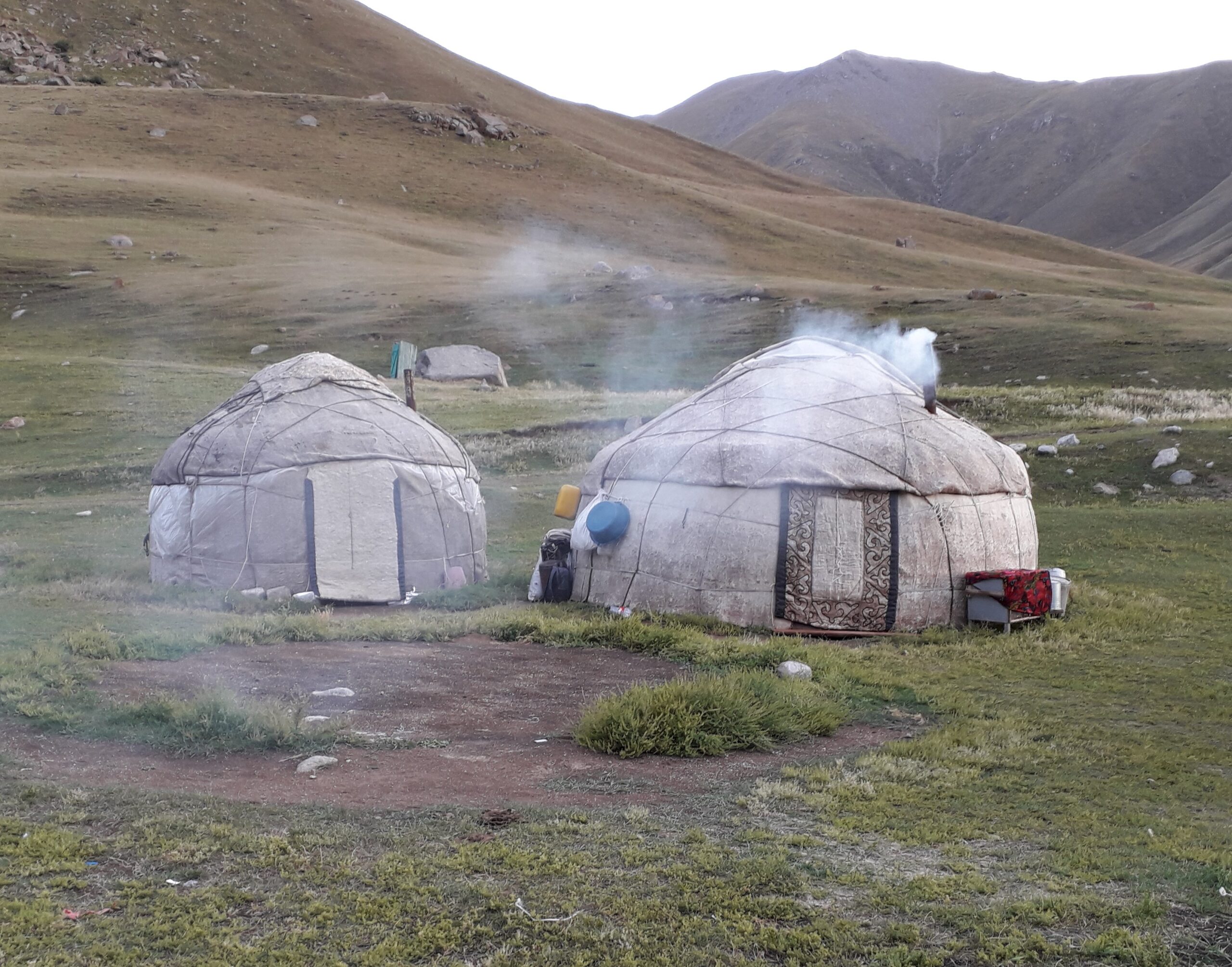Attracted by the region’s spectacular, natural landscape, an ever-increasing number of tourists descends on Central Asia each year. For many, one of the highlights, is to experience a night or two in yurts, traditional, humble felt-clad tents which in use for over 2,500 years, were homes to most of Central Asia’s nomads until the 1930’s.

Photo LH: herders’ yurts
Today’s Kazakh, and Kyrgyz herders are semi-nomadic. Winters are spent in villages but during the warmer months, they migrate with their animals to summer pastures and like their ancestors before them, live in yurts.
More than a humble abode, the yurt encapsulates the cultural, philosophical, and aesthetic values of both Kazakh and Kyrgyz people; a fact recognized by its inclusion in 2014, in the UNESCO Representative List of Intangible Cultural Heritage of Humanity.

Photo LH: shanyrak
To gain a better understanding of the cultural significance of the Kazakh yurt in particular, TCA spoke to Art historian Raushan Yeschanova who explained:
“A yurt is not just a dwelling; it is a space that reflects the entire philosophy of Kazakh nomadic culture. It is a house that carries the idea of harmony, freedom and connection with nature. The yurt serves not only as a home, but also as a place for rituals, festivals, and gatherings, making it a central element of Kazakh society.”
A yurt consists of several key elements, each of which has a meaning beyond its mere function.

Photo LH: shanyrak in situ
The Shanyrak or Crown
The most cherished component of the yurt, carefully preserved and passed down generations from fathers to sons, the ‘crown’ is a circular structure of steam-bent wood located in the center of the roof to ventilate the interior and allow the escape of smoke from the stove. The cultural importance of the Kazakh shanyrak and Kyrgyz tunduk, is such that it features on the national flags of both Kazakhstan and Kyrgyzstan.
Regarding rules in erecting the yurt, Raushan states: “In spite of the fact that construction is, as they say, a ‘man’s business’, women are actively engaged in the construction of the yurt which takes up to three hours. Its assembly is a special ritual in which each element has its own sacral meaning. Only men are permitted to handle the shanyrak which is lifted to the upper part of the frame with a forked pole known as a bakan. Perceived as a symbol of masculinity, women are forbidden to touch the bakan except during childbirth when it is retained in place for them to lean on to ease their labour.”
Kerege
The circular foundation of the yurt comprises four or more sections of folding wooden lattice linked together on diagonal axes and to the doorframe with braided rope known as saganak.
Uyk
Traditionally fashioned from wild willow, these long, steam-bent, or straight wooden poles, extend from the kerege and slot into the crown, to form the roof of the yurt.

photo LH: yurt interior
Yerenek
The yurt entrance consists of three parts: a wooden jamb, often embellished with carved designs, a colourful, painted wooden door, and an embroidered felt cape.

Photo LH: traditional doorway
The frame of the yurt is clad with felt, providing warmth and protection from the elements and Raushan notes: “Three types of felt are used to clad the frame, differing in size and shape according to function: turyrlyk for the base; uzyuk for the dome, and tundik covering the shanyrak. The creamy-white felt of pure wool, was traditionally made during the summer following specific, ancient rituals. The edges of the cloths are laced with hand-braided cord and each section, decorated with appliqued patterns of traditional geometric and zoomorphic motifs to denote the owners’ status.
“I personally believe,” said Raushan, “ that a yurt has a feminine soul, and like a woman, her body is adorned with robes and jewelry. Traditional measurements for different elements relate to parts of the human body and when we talk about the different sections, we can imagine talking about a living being. For example, each notch into which the dome’s poles are inserted is known as a kez meaning ‘eye’; the frame resembles the joints in the human hand, shoulder and forearm, reaching up to the palm-like shanyrak. The walls of the kerege are curved, echoing the shape of the human spine. The name for the dome’s felt cladding translates as ‘cape’ and the lower covering is called the hem. All the decorations of the yurt are vibrantly colourful, and what girl finds it impossible to love beautiful clothes and jewellery?!”
On a final note, Raushan stressed that in contrast to those of other Turkic peoples, Kazakh yurts are defined by their purpose, with guest yurts known as konak uy, those for newly-weds, as otau, and those erected to store and prepare food for special celebrations, as uy.
In recent years, comparatively luxurious yurts have become the go-to choice in glamping throughout Europe, but for Kazakhs and indeed, many Central Asian peoples, the traditional yurt is not just a dwelling, but a highly important symbol of their culture, traditions, and family values.
